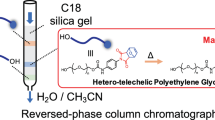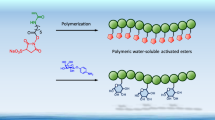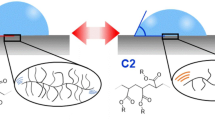Abstract
A side-chain crystalline block copolymer was applied for the chemical modification of polyethylene surfaces. A block copolymer with stearyl and epoxy groups was prepared by nitroxide-mediated living radical polymerization. This copolymer had a phase transition temperature of ~40 °C. When the side-chain crystalline block copolymer was immobilized on polyethylene, a polymeric layer with nucleophilic reactivity was formed. The layer thickness increased with increasing copolymer concentration. Galactoside ligands were added to the polymeric layer by the ring-opening addition reaction of the epoxide. The obtained glyco-functionalized interface exhibited specific protein binding; the polyethylene surface containing galactoside ligands was adsorbed to peanut agglutinin rather than wheat germ agglutinin.
This is a preview of subscription content, access via your institution
Access options
Subscribe to this journal
Receive 12 print issues and online access
$259.00 per year
only $21.58 per issue
Buy this article
- Purchase on Springer Link
- Instant access to full article PDF
Prices may be subject to local taxes which are calculated during checkout






Similar content being viewed by others
References
Varki A. Biological roles of oligosaccharides: all of the theories are correct. Glycobiology. 1993;3:97–130.
Dwek RA. Glycobiology: toward understanding the function of sugars. Chem Rev. 1996;96:683–720.
Sharon N, Lis H. History of lectins: from hemagglutinins to biological recognition molecules. Glycobiology. 2004;14:53R–62R.
Soto GE, Hultgren SJ. Bacterial adhesins: common themes and variations in architecture and assembly. J Bacteriol. 1999;181:1059–71.
Johannes L, Römer W. Shiga toxins—from cell biology to biomedical applications. Nat Rev Micro. 2010;8:105–16.
Lee CY, Lee TR. Carbohydrate-protein interactions: basis of glycobiology. Acc Chem Res. 1995;28:321–7.
Choi S-K, Mammen M, Whitesides GM. Generation and in situ evaluation of libraries of poly(acrylic acid) presenting dialosides as side chains as polyvalent inhibitors of influenza-mediated hemagglutination. J Am Chem Soc. 1997;119:4103–11.
Mammen M, Choi S-K, Whitesides GM. Polyvalent interactions in biological systems: implications for design and use of multivalent ligands and inhibitors. Angew Chem, Int Ed. 1998;37:2754–94.
Miura Y, Seto H, Fukuda T, Molecular recognition of glycopolymer interface. In: Baptista GR editor. An integrated view of the molecular recognition and toxinology—from analytical procedures to biomedical applications. London: IntechOpen; 2013. p. 455-70.
Becer CR, Hartmann L. Glycopolymer code, London: Royal Society of Chemistry; 2015.
Stine KJ. Carbohydrate nanotechnology, Hoboken: John Wiley & Sons; 2016.
Seto H, Ogata Y, Murakami T, Hoshino Y, Miura Y. Selective protein separation using siliceous materials with a trimethoxysilane-containing glycopolymer. ACS Appl Mater Interfaces. 2012;4:411–7.
Seto H, Takara M, Yamashita C, Murakami T, Hasegawa T, Hoshino Y, et al. Surface modification of siliceous materials using maleimidation and various functional polymers synthesized by reversible addition fragmentation chain transfer polymerization. ACS Appl Mater Interfaces. 2012;4:5125–33.
Ogata Y, Seto H, Murakami T, Hoshino Y, Miura Y. Affinity separation of lectins using porous membranes immobilized with glycopolymer brushes containing mannose or N-acetyl-D-glucosamine. Membranes. 2013;3:169–81.
Seto H, Kamba S, Kondo T, Hasegawa S, Nashima S, Ehara Y, et al. Metal mesh device sensor immobilized with a trimethoxysilane-containing glycopolymer for label-free detection of proteins and bacteria. ACS Appl Mater Interfaces. 2014;6:13234–41.
Seto H, Harada M, Nagaura H, Taniguchi H, Murakami T, Kimura I, et al. Formation of glyco-functionalized interfaces for protein binding using polyphenolic glycoside. Carbohydr Res. 2020;492:108002.
Seto H, Harada M, Sakamoto H, Nagaura H, Murakami T, Kimura I, et al. Visual sensing of proteins using gold nanoparticles coated with polyphenolic glycoside. Adv Powder Technol. 2020;31:4129–33.
Švorčík V, Kolářová K, Slepička P, Macková A, Novotná M, Hnatowicz V. Modification of surface properties of high and low density polyethylene by Ar plasma discharge. Polym Degrad Stab. 2006;91:1219–25.
Pascual M, Sanchis R, Sánchez L, García D, Balart R. Surface modification of low density polyethylene (LDPE) film using corona discharge plasma for technological applications. J Adhes Sci Technol. 2008;22:1425–42.
Tsuneda S, Saito K, Furusaki S, Sugo T, Makuuichi K. Simple introduction of sulfonic acid group onto polyethylene by radiation-induced cografting of sodium styrenesulfonate with hydrophilic monomers. Ind Eng Chem Res. 1993;32:1464–70.
Yao S. Crystalline supramolecular interaction of side chain crystalline polymer and their future. Kobunshi Ronbunshu. 2016;73:139–46.
Miho Y, Hirai S, Nakano R, Sekiguchi H, Yao S. Modification of polyethylene using side-chain crystalline block copolymer and evaluation of hydrophilicity. Poly J. 2018;50:439–45.
Hirai S, Ishimoto S, Phanthong P, Yao S. Development of surface properties of ultra-high-molecular-weight polyethylene film using side-chain crystalline block copolymers. J Polym Eng. 2020;40:231–6.
Hirai S, Ishimoto S, Obuchi H, Yao S. Improving the adhesion of polyethylene surfaces using Side-Chain crystalline block copolymer. J Adhes Sci Technol. 2019;33:2567–78.
Ishimoto S, Hirai S, Obuchi H, Yao S. Chemical surface modification of ultra-high-molecular-weight polyethylene fiber with side-chain crystalline block copolymers and the dyeing characteristics. J Fiber Sci Technol. 2019;75:132–9.
Mellbring O, Øiseth SK, Krozer A, Lausmaa J, Hjertberg T. Spin coating and characterization of thin high-density polyethylene films. Macromolecules. 2001;34:7496–503.
Sauerbrey G. Verwendung von schwingquarzen zur wägung dünner schichten und zur mikrowägung. Z Phys. 1959;155:206–22.
Ebara Y, Itakura K, Okahata Y. Kinetic studies of molecular recognition based on hydrogen bonding at the air-water interface by using a highly sensitive quartz-crystal microbalance. Langmuir. 1996;12:5165–70.
Matsuura K, Tsuchida A, Okahata Y, Akaike T, Kobayashi K. A quartz-crystal microbalance study of adsorption behaviors of artificial glycoconjugate polymers onto chemically modified gold surfaces and their interactions with lectins. Bull Chem Soc Jpn. 1998;71:2973–7.
Toyoshima M, Oura T, Fukuda T, Matsumoto E, Miura Y. Biological specific recognition of glycopolymer-modified interfaces by RAFT living radical polymerization. Polym J. 2010;42:172–8.
Seto H, Tono T, Nagaoka A, Yamamoto M, Hirohashi Y, Shinto H. Preparation and characterization of glycopolymers with biphenyl spacers via Suzuki coupling reaction. Org Biomol Chem. 2021;19:4474–7.
Acknowledgements
This study was supported by JSPS KAKENHI (grant number 19K05042). This study was funded by the Shiraishi Scientific Research Fund of Fukuoka University (No. SK2001) and the Central Research Institute of Fukuoka University (Nos. 165005, 175009, and 207103). We thank Nihon Kasei Co., Ltd. for providing the 4HBAGE. We thank Alkema Inc. for providing BlocBuilder® MA. XPS measurements were conducted by Dr. T. Murakami and Mr. I. Kimura of JAIST, supported by the Nanotechnology Platform Program (Molecule and Material Synthesis) of the Ministry of Education, Culture, Sports, Science and Technology (MEXT), Japan. We are grateful for the assistance of Prof. Y. Miura (Kyushu University) in providing access to the UV–Vis spectrophotometer. We thank Mr. Y. Nagano and Mr. S. Aso for their cooperation in the experiments.
Author information
Authors and Affiliations
Corresponding author
Ethics declarations
Conflict of interest
The authors declare no competing interests.
Additional information
Publisher’s note Springer Nature remains neutral with regard to jurisdictional claims in published maps and institutional affiliations.
Supplementary information
Rights and permissions
About this article
Cite this article
Seto, H., Yasunaga, M., Mawatari, N. et al. Formation of a glyco-functionalized interface on polyethylene using a side-chain crystalline block copolymer with epoxide. Polym J 54, 1103–1109 (2022). https://doi.org/10.1038/s41428-022-00652-w
Received:
Revised:
Accepted:
Published:
Issue Date:
DOI: https://doi.org/10.1038/s41428-022-00652-w



